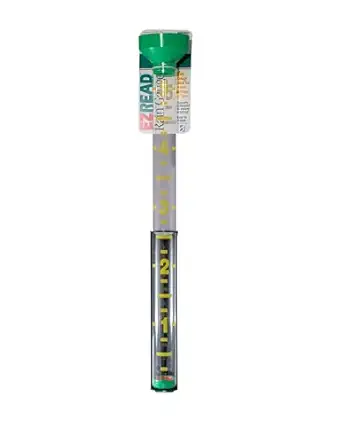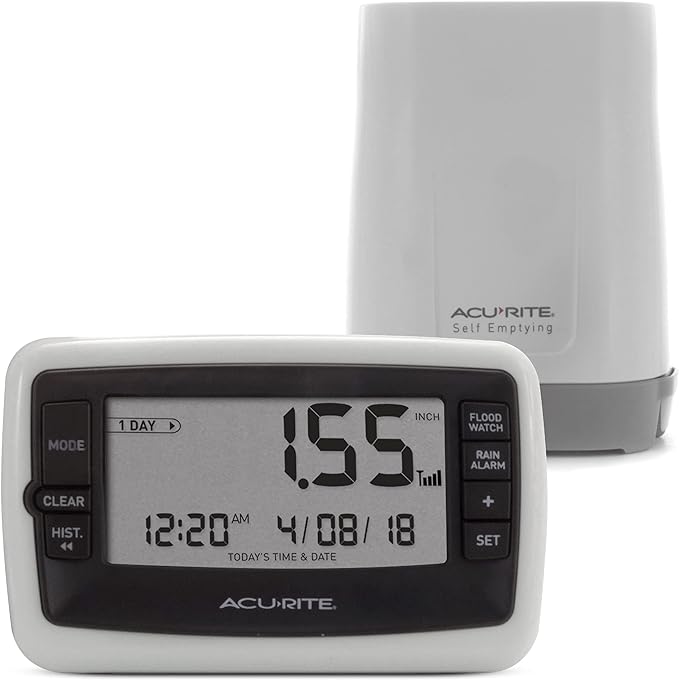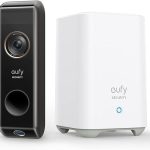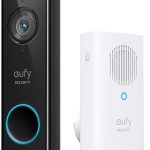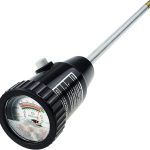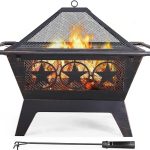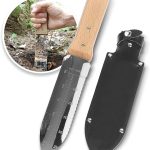Imagine waking up to find that a sudden downpour has drenched your backyard, only to realize your old rain gauge has rusted and is no longer reliable. You’re not alone – many weather enthusiasts struggle to find an accurate and durable rain gauge. As you search for a replacement, you’ll discover that the market is flooded with options, each claiming to be the best. But which ones truly deliver? From oversized tubes to wireless connectivity, what features matter most? Let’s explore the top-rated rain gauges of 2025 and uncover the perfect fit for your weather forecasting needs.
Contents
- Headwind EZRead 26″ Outdoor Rain Gauge
- Netatmo Weather Station Rain Gauge
- Stratus Precision Rain Gauge with Mounting Bracket (14 All Weather)
- AcuRite Wireless Digital Rain Gauge
- ECOWITT Wireless Weather Station with Indoor Thermometer
- Ambient Weather WS-2902 WiFi Smart Weather Station
- AcuRite Rain Gauge
- Factors to Consider When Choosing Rain Gauges
- Frequently Asked Questions
- How Often Should I Clean My Rain Gauge to Ensure Accurate Readings?
- Can Rain Gauges Be Used in Areas With Heavy Snowfall or Hail?
- Are Wireless Rain Gauges More Accurate Than Wired Ones?
- Can I Install a Rain Gauge on a Sloping Roof or Wall?
- Are Rain Gauges Suitable for Use in Coastal Areas With High Winds?
- Conclusion
Headwind EZRead 26″ Outdoor Rain Gauge
If you’re looking for a rain gauge that’s easy to read from a distance, the Headwind EZRead 26′ Outdoor Rain Gauge is the best choice, thanks to its oversized tube and high-visibility float that magnify water levels for accurate readings.
You’ll appreciate the unique funnel that prevents debris from entering the tube, ensuring you get precise measurements.
The gauge is also designed to withstand harsh weather conditions, with a weatherproof and decorative design that’s bright and colorful.
Plus, it’s easy to install and maintain, with a sieve filter to keep out debris and a plastic hanger for easy mounting.
Best For: People who want an easy-to-read and accurate rain gauge that can withstand harsh weather conditions.
Pros:
- Easy to read from a distance due to its oversized tube and high-visibility float
- Durable and weatherproof design with a unique funnel that prevents debris from entering the tube
- Easy to install and maintain with a sieve filter to keep out debris and a plastic hanger for easy mounting
Cons:
- May not be suitable for international users who prefer measurements in centimeters or millimeters
- Some users may find the measurements not precise enough, with suggestions to include readings in 10ths of an inch
- Requires removal and storage during freezing weather to prevent cracking
Netatmo Weather Station Rain Gauge
For those seeking a wireless, battery-powered rain gauge that seamlessly connects to the Netatmo Weather Station, the Netatmo Weather Station Rain Gauge is an excellent choice, providing accurate rainfall measurements and alerts sent directly to your smartphone.
You’ll appreciate its durability, as it’s designed to withstand various weather conditions.
With a range of up to 100 meters from the Weather Station’s indoor module, you can place it outdoors without worrying about connectivity issues.
The rain gauge is easy to set up, requiring only two AAA batteries and syncing with the Netatmo Weather Station through the website.
With an average rating of 3.6 out of 5 stars from over 4,500 customers, this product has proven to be a reliable choice for tracking rainfall data.
Best For: Those who want a wireless, battery-powered rain gauge that connects to the Netatmo Weather Station and provides accurate rainfall measurements and alerts.
Pros:
- Accurate rainfall measurements and alerts sent directly to your smartphone
- Durable and designed to withstand various weather conditions
- Easy to set up and sync with the Netatmo Weather Station through the website
Cons:
- Some customers have reported difficulties with the warranty process
- Requires calibration using a spray bottle to simulate rainfall, as pouring water into the gauge can lead to inaccurate readings
- Battery life may vary depending on usage and weather conditions
Stratus Precision Rain Gauge with Mounting Bracket (14 All Weather)
The Stratus Precision Rain Gauge with Mounting Bracket (14 All Weather) is an excellent choice for those seeking a reliable and precise tool for tracking precipitation.
With its ability to accurately measure rainfall to 1/100th of an inch, this gauge is ideal for those who need precise measurements.
You’ll appreciate its rugged and durable design, built with heavy-duty, UV-resistant polycarbonate that can withstand rough weather and full sun.
The gauge measures rainfall in increments of 0.01 inches up to 1 inch, and you can measure additional rainfall up to a total of 11 inches by pouring water from the outer cylinder into the inner measuring tube.
While some users find measuring multiple inches of rain inconvenient, the Stratus Precision Rain Gauge is praised for its ease of use, ease of cleaning, and durability, making it a great option for weather enthusiasts.
Best For: Weather enthusiasts and individuals seeking a reliable and precise tool for tracking precipitation.
Pros:
- Accurate to 1/100th of an inch and easy to read
- Rugged and durable, built with heavy-duty, UV-resistant polycarbonate
- Easy to use, easy to clean, and very durable
Cons:
- Measuring multiple inches of rain can be inconvenient
- The slit in the top of the measuring tube allows water to flow out, making measurements over 1 inch less accurate
- Some users reported the plastic starting to degrade and weaken after 5+ years
AcuRite Wireless Digital Rain Gauge
As you step out into the backyard, the AcuRite Wireless Digital Rain Gauge’s self-emptying collector and wireless signal penetration make it the ideal choice for homeowners seeking accurate and hassle-free rain measurements.
You’ll appreciate the convenience of its self-emptying feature, which eliminates the need for manual emptying.
This rain gauge measures total rainfall every 60 seconds and tracks rainfall history, including current rainfall events in one or seven-day measurements.
You’ll receive programmable rain alarms, including alerts for when rainfall starts, flood watch, and event rainfall.
With a strong wireless signal, you can easily monitor rain data from the comfort of your home.
Best For: Homeowners seeking accurate and hassle-free rain measurements, especially those who want to monitor rainfall data from the comfort of their homes.
Pros:
- Accurate rainfall measurements with a self-emptying collector and wireless signal penetration
- Convenient features such as programmable rain alarms and rainfall history tracking
- Easy to use and maintain, with a strong wireless signal and digital display console
Cons:
- Requires occasional cleaning and battery replacement
- May not be suitable for areas with extremely heavy rainfall or strong winds
- Some customers have reported minor issues with the product’s durability
ECOWITT Wireless Weather Station with Indoor Thermometer
The ECOWITT Wireless Weather Station with Indoor Thermometer is an excellent choice if you’re looking for a rain gauge that can provide professional rainfall data and monitor room comfort.
This 3-in-1 weather station measures rain precipitation, indoor temperature, and humidity with precision and accuracy.
It offers 0.1mm/0.01inch resolution and 300FT/100M wireless transmission range.
You’ll appreciate the programmable rain alarm, which allows you to customize alerts for rain rate, rain event, indoor temperature, and humidity.
The self-emptying rain collector is easy to install and maintain.
With a modern design and adjustable brightness, this weather station is perfect for monitoring room comfort and tracking rainfall data.
Best For: Homeowners, gardeners, and weather enthusiasts who need a reliable and accurate wireless weather station to monitor rainfall, indoor temperature, and humidity.
Pros:
- Provides professional rainfall data with high precision and accuracy
- Offers programmable rain alarm with customizable alerts for rain rate, rain event, indoor temperature, and humidity
- Features a modern design with adjustable brightness and a self-emptying rain collector that is easy to install and maintain
Cons:
- Some customers reported inaccurate rainfall readings
- A few units have been known to be faulty or stop working after a short period of time
- Some users experienced issues with the display and data transmission
Ambient Weather WS-2902 WiFi Smart Weather Station
The Ambient Weather WS-2902 WiFi Smart Weather Station provides hyper-local data, offering precise wind speed and direction, temperature, humidity, rainfall, UV intensity, and solar radiation readings.
This makes it an ideal choice for those seeking a thorough weather monitoring system.
The smart weather station is easy to set up and read, and its compatibility with smart home devices like Alexa and Google Home is a bonus.
The station’s performance is spot on, with no calibration necessary, and it measures various weather conditions, including wind speed, temperature, and UV intensity.
Although you might encounter some issues with mounting and connectivity, the customer support is easy to work with, and the warranty covers any defects or issues.
Best For: Weather enthusiasts, homeowners, and outdoor enthusiasts who want a comprehensive and accurate weather monitoring system.
Pros:
- Easy to set up and read
- Great price and value for the features and performance
- Easy to connect to Ambientweather.net and compatible with smart home devices
Cons:
- May have issues with mounting and placement
- Wind gauge may not read accurately over 99.9 mph
- May have connectivity issues
AcuRite Rain Gauge
Measuring up to 5 inches of rainwater, the AcuRite Rain Gauge is an ideal choice for those seeking an accurate and easy-to-read rain gauge for their gardens, lawns, or yards.
You’ll appreciate the magnified numbers, making it easy to read the measurements.
The durable, weather-resistant acrylic construction protects it from harsh outdoor conditions.
Plus, the integrated hang hole allows for easy mounting or staking into the ground.
With its jumbo size and precision, this wireless rain gauge is perfect for monitoring rainfall in your outdoor spaces.
Available in digital and simple rain gauge options, you can choose the one that suits your needs.
Best For: Gardeners, outdoor enthusiasts, and homeowners who want to monitor rainfall in their gardens, lawns, or yards.
Pros:
- Easy to read and use, with magnified numbers and inch markings
- Durable and weather-resistant, with a long-lasting acrylic construction
- Available in digital and simple rain gauge options to suit different needs
Cons:
- Requires careful handling to avoid breakage
- No additional features beyond measuring rainfall
- Some users may find the design or size not suitable for their specific needs
Factors to Consider When Choosing Rain Gauges
As you start shopping for a rain gauge, you’ll want to think carefully about several key factors to guarantee you find the right one for your needs.
You’ll need to ponder how accurately you need to measure rainfall, as well as how well the gauge can withstand harsh weather conditions.
Additionally, you’ll want to reflect on the installation process, wireless connectivity options, and power source requirements to make an informed decision.
Measurement Accuracy Matters
When selecting a rain gauge, prioritizing measurement accuracy is vital, since even slight discrepancies can substantially impact the reliability of weather forecasting and climate modeling.
You want a gauge that can capture and measure rainfall precisely, with high-quality options offering resolutions as low as 0.01 inches or 0.1 millimeters. The American Meteorological Society recommends an accuracy of ±1% for measurements between 0.1 and 10 inches, and ±2% for measurements above 10 inches.
To achieve this level of accuracy, look for gauges with features that minimize errors, such as self-emptying collectors that prevent evaporation and guarantee all rainfall is measured accurately.
You’ll also need to take into account wind direction, surrounding obstacles, and gauge angle when placing and installing your gauge.
Regular calibration and maintenance are vital to maintaining measurement accuracy over time, as debris, corrosion, or other issues can lead to inaccurate readings.
Durability in Weather
When choosing a rain gauge, it’s crucial to prioritize durability in weather. Rain gauges are often exposed to harsh conditions like heavy rain, strong winds, and extreme temperatures, which can affect their accuracy and longevity.
The material used to construct the rain gauge plays a significant role in its durability, with some materials being more resistant to weathering than others.
When evaluating durability, think about a rain gauge’s design features, such as a self-emptying collector or a funnel-shaped collector, which can impact its ability to withstand various weather conditions.
It’s also essential to verify the gauge can resist water intrusion, corrosion, and UV degradation. You can assess a rain gauge’s durability by checking its IP (Ingress Protection) rating, which measures its resistance to solid particles and water.
Ease of Installation
Your rain gauge’s ease of installation can greatly impact its overall performance, and a hassle-free setup is essential for accurate readings and a positive user experience.
A user-friendly design and clear instructions can make all the difference in getting your rain gauge up and running quickly and correctly. You’ll want to look for a rain gauge with a simple and tool-free installation process that saves you time and effort.
The type and quality of mounting hardware provided can greatly impact the ease of installation.
Opt for a rain gauge with sturdy and adjustable mounting options that guarantee a secure and stable setup. A compact and lightweight design can also make installation easier, especially in tight spaces or at heights.
Additionally, consider a rain gauge with a secure and stable mounting system that can withstand various weather conditions, facilitating accurate readings and minimizing the need for frequent adjustments or repairs.
Wireless Connectivity Options
As you’ve facilitated a hassle-free installation, now it’s time to ponder how you’ll stay connected to your rain gauge’s data, and that’s where wireless connectivity options come into play.
You’ll want to ponder the type of wireless connectivity that suits your needs. Wi-Fi, Bluetooth, and cellular connectivity options are commonly available, each with varying ranges and data transmission speeds.
If you want to integrate your rain gauge with smart home devices or voice assistants like Alexa or Google Home, look for models that support Internet of Things (IoT) technology.
When choosing a wireless rain gauge, ponder the transmission range, data frequency, and compatibility with your existing smart devices.
You’ll want to verify seamless integration and accurate rainfall monitoring. Many wireless rain gauges come with mobile apps that provide customizable alerts, rainfall data analytics, and historical data storage, enhancing your overall user experience.
Power Source Considerations
When selecting a rain gauge, consider the power source as a key factor, since it directly impacts the accuracy and consistency of rainfall measurements.
You’ll want a reliable power source that won’t interrupt data collection. Battery-powered rain gauges are convenient for outdoor use, but be prepared for frequent battery replacements. Additionally, battery life and weather conditions can affect their performance.
Solar-powered rain gauges offer a reliable and eco-friendly option, but they mightn’t be suitable for areas with limited sunlight.
Wireless rain gauges often rely on batteries or solar power, but they provide real-time data transmission and remote monitoring capabilities.
If you opt for a self-emptying rain collector, you’ll reduce maintenance needs, but occasional cleaning is still necessary for accurate readings.
Rainfall Data Tracking
You’ll want to track rainfall data to gain valuable insights into precipitation patterns and trends, especially since accurate measurements are essential for various applications. By monitoring rainfall data, you’ll be able to identify trends and patterns, such as seasonal variations or shifts in precipitation patterns over time.
This information is essential for informed decision-making in fields like agriculture, urban planning, and environmental management.
When selecting a rain gauge, think about the units of measurement it uses, such as inches, millimeters, or centimeters. Some gauges can track additional data, including rainfall intensity, duration, and frequency, providing a more in-depth understanding of precipitation events.
You may also want to contemplate whether the gauge displays data in real-time or stores it for later analysis.
Accurate rainfall data tracking is imperative for applications like weather forecasting, climate modeling, and water resource management.
Display Readability Issues
Your ability to accurately track rainfall data hinges on a rain gauge’s display readability, so vital is the examination of factors that affect how easily you can read the data.
A high-visibility float and water level magnification can make a significant difference, especially for those with vision impairments. Look for gauges with large, clear numerals and bold font to reduce eye strain and improve readability, even from a distance.
The color scheme and contrast of the display are also vital; bright colors and high-contrast displays are more readable, especially in low-light conditions.
Consider the angle and positioning of the display as well – a gauge that can be easily viewed from multiple angles is more convenient and user-friendly.
Finally, a backlit or illuminated display can be a game-changer, allowing you to take readings even in low-light conditions, such as at dawn, dusk, or on cloudy days.
To ensure accurate data, you must examine these factors; by doing so, you’ll be able to choose a rain gauge that provides accurate and easy-to-read data.
Material Quality Importance
As you focus on ensuring accurate rainfall data, it’s equally important to take into account the material quality of your rain gauge, since it directly impacts the gauge’s durability and reliability in various weather conditions.
You want a gauge that can withstand harsh weather conditions, not one that’ll degrade quickly or become brittle in extreme temperatures. A high-quality material like stainless steel or polycarbonate is essential, as it provides better performance and resistance to weather conditions compared to cheap plastics.
When choosing a rain gauge, consider the material’s UV resistance, as some materials can degrade quickly in direct sunlight, affecting accuracy and longevity.
Additionally, think about the material’s ability to withstand extreme temperatures, as some materials can become brittle or warp in freezing or high-temperature conditions.
A smooth, non-porous surface is also important, making cleaning and maintenance a breeze.
Frequently Asked Questions
How Often Should I Clean My Rain Gauge to Ensure Accurate Readings?
You should clean your rain gauge at least once a week, or more often in areas with high pollen or debris, to guarantee accurate readings and prevent clogs that might affect data accuracy.
Can Rain Gauges Be Used in Areas With Heavy Snowfall or Hail?
“A million snowflakes won’t stop you from getting accurate readings! You can definitely use rain gauges in areas with heavy snowfall or hail, but make sure to choose a gauge specifically designed for harsh weather conditions.”
Are Wireless Rain Gauges More Accurate Than Wired Ones?
You’re wondering if wireless rain gauges are more accurate than wired ones? Honestly, it’s a toss-up; both types can provide accurate readings, but wireless gauges might be more prone to interference, affecting their accuracy.
Can I Install a Rain Gauge on a Sloping Roof or Wall?
Like a sailor anchoring a ship, you’re securing your rain gauge in the right spot. Yes, you can install a rain gauge on a sloping roof or wall, but make certain it’s level and securely fastened to get accurate readings.
Are Rain Gauges Suitable for Use in Coastal Areas With High Winds?
You’re wondering if rain gauges can handle coastal areas with high winds. Yes, you can use them in coastal areas, but look for gauges with secure mounting systems and durable materials to withstand strong winds.
Conclusion
You’ve narrowed down your options to the top-rated rain gauges of 2025.
Now, prioritize measurement accuracy and durability in harsh weather conditions.
Consider oversized tubes, high-visibility floats, and unique funnels to prevent debris.
Look for weatherproof and decorative designs, easy installation, and maintenance with sieve filters and plastic hangers.
With wireless connectivity and self-emptying collectors, you’ll facilitate seamless data tracking and minimize errors.
Choose the best rain gauge that fits your needs, and start tracking rainfall with confidence.
